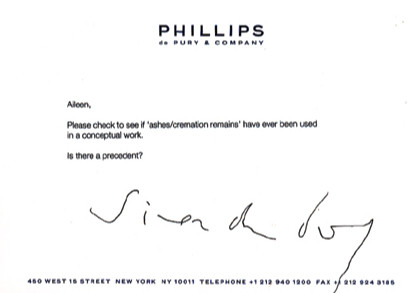Mary Ellen Carroll SEMBLABLE
11 Sep - 11 Oct 2008
white. There’s a white, one-legged busboy in here right now that won’t change places with my black ass. He’s going, „No. Man, I don’t wanna switch.“ CHRIS ROCK
Charles Baudelaire uses the word Semblable* to address his reader in his poem „Au
Lecteur “ in Les fleur du Mal . In this context of meaning semblable mirrors the unifying conceptual premise of Mary Ellen Carroll’s work - the uniqueness of things even as they exist as stand-ins, fakes, copies, impersonations, doubles, and doppelgängers. To create this exhibition, Carroll has ruminated on the complexities of interpretation, reading and misreading, and drawn on existing significant bodies of her oeuvre, including some works that have never before been shown. In addition, she will make a new sculpture specifically for the exhibition.
Many of the works on view relate to racial identity and the vagaries of how one is
perceived socially. In 2007, Carroll staged an exhibition based on impersonation in the city of impersonators, Memphis, Tennessee. Its centerpiece, ME LIKE BLACK, consists of two neon signs that refer to the 1961 book Black Like Me by the white journalist John Howard Griffin, a civil-rights activist and friend of Dr. Martin Luther King who disguised himself as a black man and chronicled the experience. That show also featured four silkscreen paintings based on works that appeared in Carroll’s One Star Press publication All the Men Think They Can Be Me (2003); here, they will be presented alongside a selection of original drawings from that book. In more direct references to reading and misreading, Mary Ellen Carroll-Semblable will also feature previously unexhibited works related to two literary figures. From 1998-1999, Carroll drew the entirety of Laurence Sterne’s The Life and Opinions of Tristram Shandy on a single sheet of Arches watercolor paper. The text became a solid mass, referring to the black page in Sterne’s novel. Once the rewriting was complete, Carroll made Alas, poor Yorick! a silkscreen of the paper at a one-to-one scale. Ten years later Carroll burned the original while filming the act in Super-8. The print, the film, and a drawing made with the original’s ashes of the black page will all be shown. Carroll’s new sculpture Semblable is based on Rodin’s Baudelaire (1898), which depicts not Baudelaire but a young artist who resembled Baudelaire. Carroll will atavistically use herself as the poet-artist-model to remake the bust in the modeling materiel plastalina, which never reaches a hardened state of so-called permanence. Rodin spoke of how we recall an individual’s characteristics according to the cerebral conformation that constitutes what one calls “type”; hence we relinquish the need for the actual. In effect, the conformation validates the idea that we are all similar-semblable-if only in that we are all too human.
On the opening night of the exhibition, Mary Ellen Carroll will become the subject and
object of the artwork during a special performance.
*Semblable is the title of Jonathan Flatley’s lead essay in Carroll’s forthcoming monograph, to be published this fall by Steidl/Mack.
Charles Baudelaire uses the word Semblable* to address his reader in his poem „Au
Lecteur “ in Les fleur du Mal . In this context of meaning semblable mirrors the unifying conceptual premise of Mary Ellen Carroll’s work - the uniqueness of things even as they exist as stand-ins, fakes, copies, impersonations, doubles, and doppelgängers. To create this exhibition, Carroll has ruminated on the complexities of interpretation, reading and misreading, and drawn on existing significant bodies of her oeuvre, including some works that have never before been shown. In addition, she will make a new sculpture specifically for the exhibition.
Many of the works on view relate to racial identity and the vagaries of how one is
perceived socially. In 2007, Carroll staged an exhibition based on impersonation in the city of impersonators, Memphis, Tennessee. Its centerpiece, ME LIKE BLACK, consists of two neon signs that refer to the 1961 book Black Like Me by the white journalist John Howard Griffin, a civil-rights activist and friend of Dr. Martin Luther King who disguised himself as a black man and chronicled the experience. That show also featured four silkscreen paintings based on works that appeared in Carroll’s One Star Press publication All the Men Think They Can Be Me (2003); here, they will be presented alongside a selection of original drawings from that book. In more direct references to reading and misreading, Mary Ellen Carroll-Semblable will also feature previously unexhibited works related to two literary figures. From 1998-1999, Carroll drew the entirety of Laurence Sterne’s The Life and Opinions of Tristram Shandy on a single sheet of Arches watercolor paper. The text became a solid mass, referring to the black page in Sterne’s novel. Once the rewriting was complete, Carroll made Alas, poor Yorick! a silkscreen of the paper at a one-to-one scale. Ten years later Carroll burned the original while filming the act in Super-8. The print, the film, and a drawing made with the original’s ashes of the black page will all be shown. Carroll’s new sculpture Semblable is based on Rodin’s Baudelaire (1898), which depicts not Baudelaire but a young artist who resembled Baudelaire. Carroll will atavistically use herself as the poet-artist-model to remake the bust in the modeling materiel plastalina, which never reaches a hardened state of so-called permanence. Rodin spoke of how we recall an individual’s characteristics according to the cerebral conformation that constitutes what one calls “type”; hence we relinquish the need for the actual. In effect, the conformation validates the idea that we are all similar-semblable-if only in that we are all too human.
On the opening night of the exhibition, Mary Ellen Carroll will become the subject and
object of the artwork during a special performance.
*Semblable is the title of Jonathan Flatley’s lead essay in Carroll’s forthcoming monograph, to be published this fall by Steidl/Mack.

